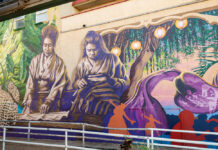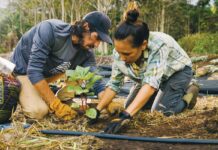Most of the funding in the years since has come from the County, with some from fundraisers and from the Office of Hawaiian Affairs (OHA). Labor and skills came from members of the community, with neighbor Rich von Wellsheim providing informal supervision. Students from the Hana High School program called Ma ka Hana ka Ike (through doing one learns) lent the building skills they were learning at school from teacher Rick Rutiz, also a Kipahulu resident.
Now the stainless-steel sinks and eight-burner Wolf range are installed, solar panels are on the roof, and permits are in order. An OHA grant is paying for research into a possible solar-powered icemaker. The tall roof built to designer Bruce Hopper’s specifications covers a kitchen and an open concrete-floored area where farm equipment can drive in to drop off a load of fresh produce.
Installing a certified kitchen is complicated any time, but it’s been quite a challenge in this isolated area, says project coordinator Scott Crawford. With no power lines reaching the area, electricity must come from photovoltaic panels. There is no county water line, so potable water will be stored in 250-gallon tanks on trailers, filled at a county water outlet 15 minutes away.
Crawford says the kitchen should be ready to use this spring. Now the neighbors who worked together on construction are developing protocols for efficient and harmonious sharing of the new facility. The Kipahulu community is using a manual borrowed from a certified community kitchen in Wai‘anae on O‘ahu as a template for rules on things like clean-up requirements, work scheduling, and how to charge for water and propane use.
All involved emphasize that, though the sign outside says “Kalena Center,” this is not a traditional community center, a place for parties, weddings, and baby lu‘au. It is a place for work, located in an agricultural district with residents nearby who value their peaceful isolation.
But that doesn’t mean that it’s not a focal point for the neighborhood. From the beginning, the idea was that “it would become an anchor for the whole community,” says Hamilton.
The interaction Kalena Center’s construction required among segments of the community that might not otherwise spend much time together has been important, says Crawford. “There is a connection between the newcomers and the Hawaiians, and the spirit of working together.”
Tweetie Lind agrees. “What’s good about it is that we were working together, getting to know each other. We’re Hawaiians, and we work with our community. This has brought
the community even tighter.”
The neighbors plan to continue getting together at their new kitchen every Thanksgiving, just as they have done during the years when they worked to raise the roof and walls. Next year, food cooked in the kitchen will be part of the feast.





